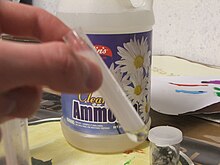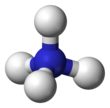Ammonia solution
| |||
| |||
| Names | |||
|---|---|---|---|
| IUPAC name
Ammonium hydroxide
| |||
Other names
| |||
| Identifiers | |||
3D model (JSmol)
|
|||
| ChEBI | |||
| ChemSpider | |||
| ECHA InfoCard | 100.014.225 | ||
| EC Number |
| ||
| E number | E527 (acidity regulators, ...) | ||
| KEGG | |||
PubChem CID
|
|||
| RTECS number |
| ||
| UNII | |||
| UN number | 2672 | ||
CompTox Dashboard (EPA)
|
|||
| |||
| |||
| Properties[1] | |||
| NH3(aq) | |||
| Molar mass | 17.031 g/mol | ||
| Appearance | Colourless liquid | ||
| Odor | "Fishy", highly pungent | ||
| Density | 0.91 g/cm3 (25 % w/w) 0.88 g/cm3 (35 % w/w) | ||
| Melting point | −57.5 °C (−71.5 °F; 215.7 K) (25 % w/w) −91.5 °C (35% w/w) | ||
| Boiling point | 37.7 °C (99.9 °F; 310.8 K) (25 % w/w) | ||
| Miscible | |||
| −31.5×10−6 cm3/mol | |||
| Thermochemistry | |||
Std molar
entropy (S⦵298) |
111 J/(mol·K)[2] | ||
Std enthalpy of
formation (ΔfH⦵298) |
−80 kJ/mol[2] | ||
| Hazards[4][5] | |||
| Occupational safety and health (OHS/OSH): | |||
Main hazards
|
Moderately toxic and irritating towards mucous membranes | ||
| GHS labelling: | |||
   
| |||
| Danger | |||
| H302, H314, H335, H410 | |||
| P261, P271, P273, P280, P303+P361+P353, P305+P351+P338 | |||
| NFPA 704 (fire diamond) | |||
| Lethal dose or concentration (LD, LC): | |||
LD50 (median dose)
|
100 — 200 mg/kg[3] | ||
| Safety data sheet (SDS) | ICSC 0215 (10%-35% solution) | ||
| Related compounds | |||
Other anions
|
Ammonium chloride Ammonium cyanide | ||
Other cations
|
Tetramethylammonium hydroxide | ||
Related compounds
|
Ammonia Hydroxylamine | ||
Except where otherwise noted, data are given for materials in their standard state (at 25 °C [77 °F], 100 kPa).
| |||
Ammonia solution, also known as ammonia water, ammonium hydroxide, ammoniacal liquor, ammonia liquor, aqua ammonia, aqueous ammonia, or (inaccurately) ammonia, is a solution of ammonia in water. It can be denoted by the symbols NH3(aq). Although the name ammonium hydroxide suggests a salt with the composition [NH+
4][OH−
], it is actually impossible to isolate samples of NH4OH. The ions NH+
4 and OH− do not account for a significant fraction of the total amount of ammonia except in extremely dilute solutions.[6]
The concentration of such solutions is measured in units of the Baumé scale (density), with 26 degrees Baumé (about 30% of ammonia by weight at 15.5 °C or 59.9 °F) being the typical high-concentration commercial product.[7]
Basicity of ammonia in water
[edit]In aqueous solution, ammonia deprotonates a small fraction of the water to give ammonium and hydroxide according to the following equilibrium:
- NH3 + H2O ⇌ NH+
4 + OH−.
In a 1 M ammonia solution, about 0.42% of the ammonia is converted to ammonium, equivalent to pH = 11.63
because [NH+
4] = 0.0042 M, [OH−] = 0.0042 M, [NH3] = 0.9958 M, and pH = 14 + log10[OH−] = 11.62. The base ionization constant is
- Kb = [NH+
4][OH−]/[NH3] = 1.77×10−5.
Saturated solutions
[edit]Like other gases, ammonia exhibits decreasing solubility in solvent liquids as the temperature of the solvent increases. Ammonia solutions decrease in density as the concentration of dissolved ammonia increases. At 15.6 °C (60.1 °F), the density of a saturated solution is 0.88 g/ml and contains 35.6% ammonia by mass, 308 grams of ammonia per litre of solution, and has a molarity of approximately 18 mol/L. At higher temperatures, the molarity of the saturated solution decreases and the density increases.[8] Upon warming of saturated solutions, ammonia gas is released.
Applications
[edit]In contrast to anhydrous ammonia, aqueous ammonia finds few non-niche uses outside of cleaning agents.
Household cleaner
[edit]This section may require cleanup to meet Wikipedia's quality standards. The specific problem is: Multiple repetitions of use and properties. (July 2024) |

Household 'ammonia' is a solution of NH3 in water, and is used as a general purpose cleaner for many surfaces. Because ammonia results in a relatively streak-free shine, one of its most common uses is to clean glass, porcelain, and stainless steel. It is also frequently used for cleaning ovens and for soaking items to loosen baked-on grime. Household ammonia ranges in concentration by weight from 5% to 10% ammonia.[9] US manufacturers of cleaning products are required to provide the product's material safety data sheet that lists the concentration used.[10]
Solutions of ammonia (5–10% by weight) are used as household cleaners, particularly for glass. These solutions are irritating to the eyes and mucous membranes (respiratory and digestive tracts), and to a lesser extent the skin. Experts advise that caution be used to ensure the chemical is not mixed into any liquid containing bleach, due to the danger of forming toxic chloramine gas. Mixing with chlorine-containing products or strong oxidants, such as household bleach, can generate toxic chloramine fumes.[11]
Experts also warn not to use ammonia-based cleaners (such as glass or window cleaners) on car touchscreens, due to the risk of damage to the screen's anti-glare and anti-fingerprint coatings.[12]
Diluted (1–3%) ammonia is also an ingredient of numerous cleaning agents, including many window cleaning formulas.[13] Because aqueous ammonia is a gas dissolved in water, as the water evaporates from a window, the gas evaporates also, leaving the window streak-free.
In addition to use as an ingredient in cleansers with other cleansing ingredients, ammonia in water is also sold as a cleaning agent by itself, usually labeled as simply "ammonia". It may be sold plain, lemon-scented (and typically colored yellow), or pine-scented (green). Commonly available ammonia with soap added is known as "cloudy ammonia".
Alkyl amine precursor
[edit]In industry, aqueous ammonia can be used as a precursor to some alkyl amines, although anhydrous ammonia is usually preferred. Hexamethylenetetramine forms readily from aqueous ammonia and formaldehyde. Ethylenediamine forms from 1,2-dichloroethane and aqueous ammonia.[14]
Absorption refrigeration
[edit]In the early years of the twentieth century, the vapor absorption cycle using water-ammonia systems was popular and widely used, but after the development of the vapor compression cycle it lost much of its importance because of its low coefficient of performance (about one fifth of that of the vapor compression cycle). Both the Electrolux refrigerator[15] and the Einstein refrigerator are well known examples of this application of the ammonia solution.
Water treatment
[edit]Ammonia is used to produce chloramine, which may be utilised as a disinfectant.[16] In drinking water, chloramine is preferred over direct chlorination for its ability to remain active in stagnant water pipes longer, thereby reducing the risk of waterborne infections.
Ammonia is used by aquarists for the purposes of setting up a new fish tank using an ammonia process called fishless cycling.[17] This application requires that the ammonia contain no additives.
Food production
[edit]Baking ammonia (ammonium carbonate and ammonium bicarbonate) was one of the original chemical leavening agents. It was obtained from deer antlers.[18] It is useful as a leavening agent, because ammonium carbonate is heat activated. This characteristic allows bakers to avoid both yeast's long proofing time and the quick CO2 dissipation of baking soda in making breads and cookies rise. It is still used to make ammonia cookies and other crisp baked goods, but its popularity has waned because of ammonia's off-putting smell and concerns over its use as a food ingredient compared to modern-day baking powder formulations. It has been assigned E number E527 for use as a food additive in the European Union.
Aqueous ammonia is used as an acidity regulator to bring down the acid levels in food. It is classified in the United States by the Food and Drug Administration as generally recognized as safe (GRAS) when using the food grade version.[19] Its pH control abilities make it an effective antimicrobial agent.
Furniture darkening
[edit]In furniture-making, ammonia fuming was traditionally used to darken or stain wood containing tannic acid. After being sealed inside a container with the wood, fumes from the ammonia solution react with the tannic acid and iron salts naturally found in wood, creating a rich, dark stained look to the wood. This technique was commonly used during the Arts and Crafts movement in furniture – a furniture style which was primarily constructed of oak and stained using these methods.[20]
Treatment of straw for cattle
[edit]Ammonia solution is used to treat straw, producing "ammoniated straw" making it more edible for cattle.[21]
Laboratory use
[edit]Aqueous ammonia is used in traditional qualitative inorganic analysis as a complexant and base. Like many amines, it gives a deep blue coloration with copper(II) solutions. Ammonia solution can dissolve silver oxide residues, such as those formed from Tollens' reagent. It is often found in solutions used to clean gold, silver, and platinum jewelry, but may have adverse effects on porous gem stones like opals and pearls.[22]
See also
[edit]References
[edit]- ^ Record of Ammonia solution in the GESTIS Substance Database of the Institute for Occupational Safety and Health .
- ^ a b Zumdahl, Steven S. (2009). Chemical Principles 6th Ed. Houghton Mifflin Company. p. A22. ISBN 978-0-618-94690-7.
- ^ Ammonium hydroxide toxicity
- ^ C&L Inventory.
- ^ "GESTIS-Stoffdatenbank". gestis.dguv.de.
- ^ Housecroft, C. E.; Sharpe, A. G. (2004). Inorganic Chemistry (2nd ed.). Prentice Hall. p. 187. ISBN 978-0-13-039913-7.
- ^ "Ammonium hydroxide physical properties" (PDF). Archived from the original (PDF) on 27 November 2007.
- ^ Max Appl (2006). "Ammonia". Ammonia, in Ullmann's Encyclopedia of Industrial Chemistry. Weinheim: Wiley-VCH. doi:10.1002/14356007.a02_143.pub2. ISBN 978-3527306732.
- ^ "The Facts About Ammonia". www.health.ny.gov. Retrieved 6 April 2018.
- ^ "OSHA Hazard Communication Standard: Safety Data Sheets" (PDF). OSHA. Archived (PDF) from the original on 9 October 2022.
- ^ Rizk-Ouaini, Rosette; Ferriol, Michel; Gazet, Josette; Saugier-Cohen Adad; Marie Therese (2006). "Oxidation reaction of ammonia with sodium hypochlorite. Production and degradation reactions of chloramines". Bulletin de la Société Chimique de France. 4: 512. doi:10.1002/14356007.a02_143.pub2. ISBN 978-3527306732.
- ^ Barry, Keith. "How To Clean Your Car's Interior". Consumer Reports. Retrieved 31 January 2021.
- ^ Christian Nitsch; Hans-Joachim Heitland; Horst Marsen; Hans-Joachim Schlüussler (2005). "Cleansing Agents". Ullmann’s Encyclopedia of Industrial Chemistry. Weinheim: Wiley-VCH. doi:10.1002/14356007.a07_137. ISBN 978-3527306732.
- ^ Eller, Karsten; Henkes, Erhard; Rossbacher, Roland; Höke, Hartmut (2000). "Amines, Aliphatic". Ullmann's Encyclopedia of Industrial Chemistry. doi:10.1002/14356007.a02_001. ISBN 978-3-527-30673-2.
- ^ Vapour Absorption Cycle - Domestic Electrolux Refrigerator
- ^ "Chloramines in Drinking Water". EPA. US Environmental Protection Agency. 20 October 2015. Retrieved 6 March 2018.
- ^ "Fishless Cycling". Aquarium Advice. 12 April 2011. Retrieved 6 March 2018.
- ^ Olver, Lynne (24 June 2012). "history notes—cookies, crackers & biscuits". The Food Timeline. Archived from the original on 17 July 2012. Retrieved 6 January 2021.
- ^ Database of Select Committee on GRAS Substances (SCOGS) Reviews: Ammonium hydroxide, U.S. Food and Drug Administration
- ^ Rigers, Shayne; Umney, Nick (12 August 2009). "Acidic and alkaline stains". Wood Coatings: Theory and Practice. Amsterdam: Elsevier. pp. 618–9. ISBN 978-0-444-52840-7.
- ^ "Is it Bedding or is it Feed? | Ohio BEEF Cattle Letter".
- ^ The Jeweler's Bench. 2015. Fine Jewelry Cleaner. Littleton, Colo.
Further reading
[edit]- Geornaras, I.; Sofos, J. N. (2005). "Combining physical and chemical decontamination interventions for meat". In Sofos, John Nikolaos (ed.). Improving the safety of fresh meat. Boca Raton: CRC Press. pp. 433–60. ISBN 978-0-8493-3427-6.
- Skandamis, Panagiotis N.; Nychas, George-John E.; Sofos, John N. (2010). "Meat Decontamination". In Toldrá, Fidel (ed.). Handbook of Meat Processing. Ames: Iowa State University Press. pp. 43–85. doi:10.1002/9780813820897.ch3. ISBN 978-0-8138-2089-7.
- Edwards, Jessica Renee; Fung, Daniel Y.C. (2006). "Prevention and Decontamination of Escherichia Coli O157:h7 on Raw Beef Carcasses in Commercial Beef Abattoirs". Journal of Rapid Methods and Automation in Microbiology. 14 (1): 1–95. doi:10.1111/j.1745-4581.2006.00037.x.
External links
[edit]- External Material Safety Data Sheet – for ammonium hydroxide (10%-35% solution).





